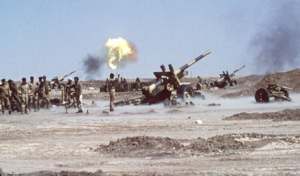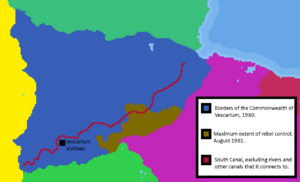South Canal Crisis: Difference between revisions
mNo edit summary |
mNo edit summary |
||
| Line 3: | Line 3: | ||
| image = Southcanalartillery.png | | image = Southcanalartillery.png | ||
| image_size = 300px | | image_size = 300px | ||
| caption = Mutineer artillery shelling | | caption = Mutineer artillery shelling Vescarian positions near the South Canal, May 1981. | ||
| date = 13 April – 24 October 1981<br />({{Age in years, months, weeks and days|month1=4|day1=13|year1=1981|month2=10|day2=24|year2=1981}})<br /> | | date = 13 April – 24 October 1981<br />({{Age in years, months, weeks and days|month1=4|day1=13|year1=1981|month2=10|day2=24|year2=1981}})<br /> | ||
| place = [[Vescarium]] | | place = [[Vescarium]] | ||
Revision as of 04:30, 24 June 2021
| South Canal Crisis | |||||||
|---|---|---|---|---|---|---|---|
 Mutineer artillery shelling Vescarian positions near the South Canal, May 1981. | |||||||
| |||||||
| Belligerents | |||||||
| Commonwealth of Vescarium |
Free Army of Vescarium Pomaz's Mutiny | ||||||
| Commanders and leaders | |||||||
|
Cornelius Trajanus † Laurențiu Viteazu Gaius Miloslavus Sternacius Cicero (After August 3) |
Aszod Pomaz Claudius Aurelius Viorica Mureșanu Sternacius Cicero (Before August 3) | ||||||
| Units involved | |||||||
| Vescarian Armed Forces |
Free Army of Vescarium Pomaz's Mutiny | ||||||
| Strength | |||||||
| 14,950 personnel |
8,200 soldiers 4,000 militiamen | ||||||
| Casualties and losses | |||||||
|
1,040 killed 165 wounded |
3,730 killed 270 wounded 3,291 captured | ||||||
The South Canal Crisis was a short-lived military mutiny turned open revolution that occurred within Vescarium in 1981. When agrarian-communist Aszod Pomaz was granted control of the 19th and 25th Infantry Brigades of the Vescarian Armed Forces in January of 1981, he conspired with his ideological colleague Claudius Aurelius, who was in control of the 9th Artillery Brigade, to overthrow the government by capturing the vital South Canal waterway, which provides fresh water to the capital city of Vescarium Vurbaes. They were also joined by the Free Army of Vescarium, an agrarian-collectivist left-terror militia unaffiliated with the Syndicalist Union of Vescarium, who offered to provide extra manpower for the inevitable uprising. When the Crisis began in April of 1981, the Vescarian army was taken by surprise, and hastily scrambled to retaliate. Their initial counteroffensives failed due to incredibly poor organization and suicidal tactics. However, as the weeks passed, the Vescarian army began to slowly learn from it's mistakes, and by the end of July it was clear that the revolt would inevitably fail. Sternacius Cicero, one of the commanders of the Free Army of Vescarium, defected to the government on August 3, signalling the beginning of the end for the revolution. The Crisis would not end until October, when Pomaz himself was captured by PRI agents, causing his army to collapse and offer unconditional surrender on October 24.
Background
The Syndicalist Union of Vescarium had been a dominant force in underground politics and insurgent activity during the 1950's and 1960's, though by the late 1970's factionalism took hold, and the Union waned in power. These schisms had led to the splintering of Ciobanist-oriented militia groups, most notably the Free Army of Vescarium, away from the Union. These groups disliked the decentralized, syndicalist policies of the Union, and preferred staunchly authoritarian agrarian socialism instead. Paradoxically, the FAV was most popular in the southern deserts, where food was scarce and neglect of the irrigation systems by the Commonwealth government had spurred on local unrest.
It was also during the 1970's that public hatred for the far-left began to cool, due to the aforementioned decline of the Union. While the SUV continued to remain a thorn in the government's side, anti-syndicalist policies were slowly beginning to disappear. Naturally, non-SUV groups such as the FAV were eager to capitalize on this. FAV influence spread throughout the Far South, with the exception of the industrial region of the southwest. Included in that area was Vescarium Vurbaes, the nation's capital, which still housed very stringent anti-syndicalist sentiments.
Leadup to Rebellion
In 1979, Aszod Pomaz was granted the position of Legatus Inferioris (equivalent in rank to that of a Brigadier General in most other armies) and placed in charge of two army brigades approximately 100 kilometers from the Shadoveilan border. These units, the 19th and 25th Infantry Brigades of the Vescarian Armed Forces, were generally in poor condition, utilizing poorly trained and inadequately equipped troops, primarily ethnically Plagyor. Pomaz, a secret FAV sympathizer, worked diligently to raise the units up to more effective levels throughout 1979 and 1980, in hopes of gaining their loyalty in his coming plans.
Also around this time, the Free Army had reached out to the Legate, and the conspiracy which they would inevitably execute began to form in early 1980. The Free Army began receiving VAF-level training and equipment, and the overall preparations for the revolt had been completed by January of 1981, faster than anticipated. Viorica Mureșanu, a major terrorist leader within the FAV, urged Aszod to launch the revolt in January or February, before the deserts of the Vescarian Far South became too much of an attritional and fatigue problem. However, the Legate hesitated, fearing that holding off until the spring months would allow more revolutionaries further north to mobilize, particularly around Choretu and Csatorna, which were historical centers of left-wing fervor. In the end, Mureșanu won out by conscripting the help of nearby artillery commander Claudius Aurelius, and the revolt was sprung on April 13, 1981.
The Crisis
April: The War Begins
Immediately upon the declaration of his revolt, Pomaz ordered his troops, numbering approximately 8,200 combat personnel between the two brigades, to occupy the small villages and outposts in their immediate area. The other local units skirmished with the mutineers, though ultimately a lack of coordination and the hesitation of other commanders forced these units to retreat from their positions, allowing the mutineer army to occupy much of the desert. 75 kilometers west of the mutiny, 4,000 FAV insurgents had gathered at the small village of Iovenesa, rapidly securing the town and declaring FAV support for the rebellion within the next week.
However, Aszod was still hesitant to utilize his initiative to it's fullest extent. He was still anticipating the uprising of workers across the country, and deliberated on major offensives for the remainder of April. When it became clear these peasants would not revolt in support of him, it was already too late; the VAF had begun to respond by moving just short of 15,000 troops to the South Canal, to reinforce it and prevent the capture of the vital artery. The FAV, meanwhile, was breaking through the unsupported units south of the Canal, linking up with the mutineer force On April 29.
May: Ineffective Response
Despite the apprehension of the mutineer army to push forward, similar fears were expressed by the command staff of the VAF early in the crisis. As April turned to May, Legatus Superioris (equivalent in rank to a Lieutenant General) Cornelius Trajanus was worried that the workers on the South Canal would strike if he left them to their own devices. A contingent of 600 VAF soldiers, under the command of Centurion Major (Major) Gaius Miloslavus was tasked with the enforcement of emergency martial law along the Canal, leading to the infamous Bacaresa Tragedy on May 16, where a contingent of Miloslavus' soldiers opened fire on a group of workers near the town of Bacaresa, believing them to be pro-Syndicalist demonstrators sympathetic to the rebels. The incident was covered up successfully for the remainder of the month, to avoid inciting further protests.
Meanwhile, along the front, very little combat was taking place. Artillery skirmishes were extremely frequent, though a lack of air power on the side of the rebels meant that coordinated counterbattery fire could be orchestrated by the VAF. Cleverly, however, many rebel forces camouflaged their guns well, blending them in with the tan dunes using military equipment they had stockpiled the previous year. In effect, the indirect stalemate continued, and the deadlock remained throughout the month. Not even the FAV militias engaged in much fighting; their adversaries were better equipped and in much greater numbers, and thus FAV commanders believed that an offensive to break the stalemate would be too costly on the mutiny's limited resources.
